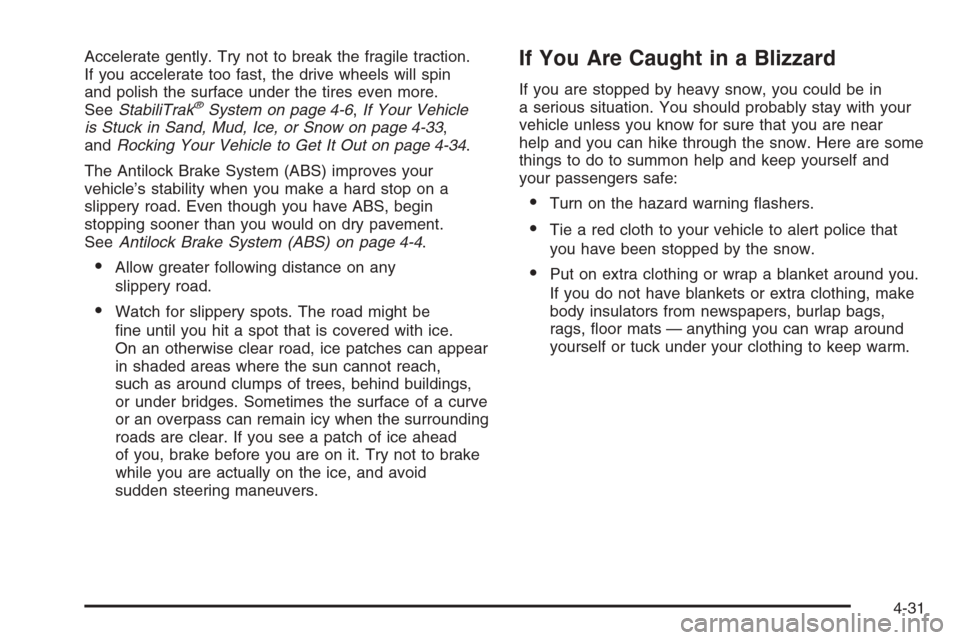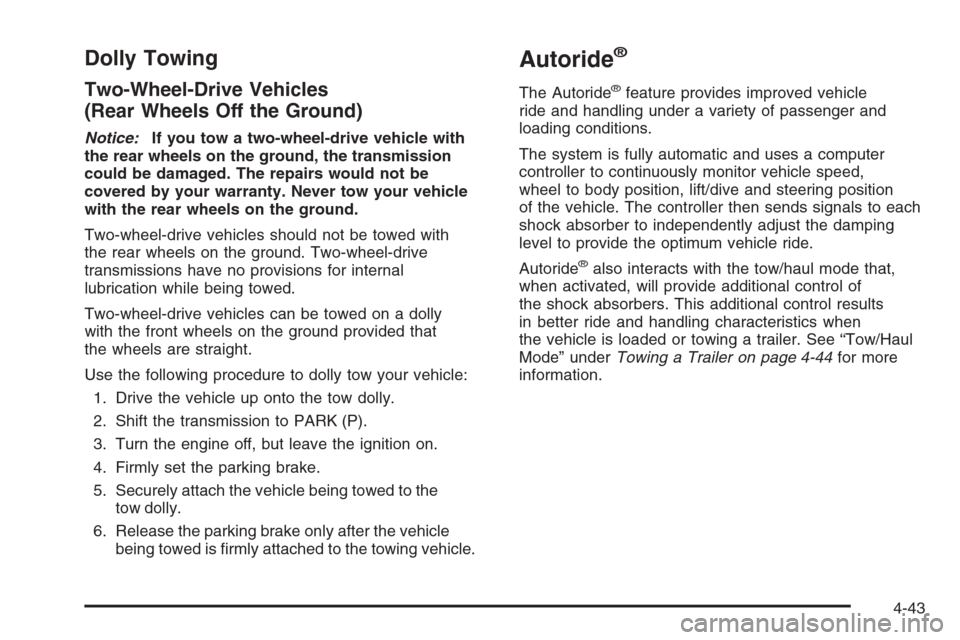2008 CADILLAC ESCALADE ABS
[x] Cancel search: ABSPage 299 of 490

Accelerate gently. Try not to break the fragile traction.
If you accelerate too fast, the drive wheels will spin
and polish the surface under the tires even more.
SeeStabiliTrak
®System on page 4-6,If Your Vehicle
is Stuck in Sand, Mud, Ice, or Snow on page 4-33,
andRocking Your Vehicle to Get It Out on page 4-34.
The Antilock Brake System (ABS) improves your
vehicle’s stability when you make a hard stop on a
slippery road. Even though you have ABS, begin
stopping sooner than you would on dry pavement.
SeeAntilock Brake System (ABS) on page 4-4.
Allow greater following distance on any
slippery road.
Watch for slippery spots. The road might be
�ne until you hit a spot that is covered with ice.
On an otherwise clear road, ice patches can appear
in shaded areas where the sun cannot reach,
such as around clumps of trees, behind buildings,
or under bridges. Sometimes the surface of a curve
or an overpass can remain icy when the surrounding
roads are clear. If you see a patch of ice ahead
of you, brake before you are on it. Try not to brake
while you are actually on the ice, and avoid
sudden steering maneuvers.
If You Are Caught in a Blizzard
If you are stopped by heavy snow, you could be in
a serious situation. You should probably stay with your
vehicle unless you know for sure that you are near
help and you can hike through the snow. Here are some
things to do to summon help and keep yourself and
your passengers safe:
Turn on the hazard warning �ashers.
Tie a red cloth to your vehicle to alert police that
you have been stopped by the snow.
Put on extra clothing or wrap a blanket around you.
If you do not have blankets or extra clothing, make
body insulators from newspapers, burlap bags,
rags, �oor mats — anything you can wrap around
yourself or tuck under your clothing to keep warm.
4-31
Page 311 of 490

Dolly Towing
Two-Wheel-Drive Vehicles
(Rear Wheels Off the Ground)
Notice:If you tow a two-wheel-drive vehicle with
the rear wheels on the ground, the transmission
could be damaged. The repairs would not be
covered by your warranty. Never tow your vehicle
with the rear wheels on the ground.
Two-wheel-drive vehicles should not be towed with
the rear wheels on the ground. Two-wheel-drive
transmissions have no provisions for internal
lubrication while being towed.
Two-wheel-drive vehicles can be towed on a dolly
with the front wheels on the ground provided that
the wheels are straight.
Use the following procedure to dolly tow your vehicle:
1. Drive the vehicle up onto the tow dolly.
2. Shift the transmission to PARK (P).
3. Turn the engine off, but leave the ignition on.
4. Firmly set the parking brake.
5. Securely attach the vehicle being towed to the
tow dolly.
6. Release the parking brake only after the vehicle
being towed is �rmly attached to the towing vehicle.
Autoride®
The Autoride®feature provides improved vehicle
ride and handling under a variety of passenger and
loading conditions.
The system is fully automatic and uses a computer
controller to continuously monitor vehicle speed,
wheel to body position, lift/dive and steering position
of the vehicle. The controller then sends signals to each
shock absorber to independently adjust the damping
level to provide the optimum vehicle ride.
Autoride
®also interacts with the tow/haul mode that,
when activated, will provide additional control of
the shock absorbers. This additional control results
in better ride and handling characteristics when
the vehicle is loaded or towing a trailer. See “Tow/Haul
Mode” underTowing a Trailer on page 4-44for more
information.
4-43
Page 319 of 490

If you use a step-bumper hitch, the bumper could be
damaged in sharp turns. Make sure there is ample
room when turning to avoid contact between the trailer
and the bumper.
If you’ll be pulling a trailer that, when loaded, will
weigh more than 5,000 lbs (2 270 kg) be sure to use
a properly mounted weight-distributing hitch and
sway control of the proper size. This equipment is
very important for proper vehicle loading and good
handling when driving. You should always use a
sway control if your trailer will weigh more than these
limits. You can ask a hitch dealer about sway controls.
Hitch Cover
Your vehicle may have a hitch cover. To remove the
hitch cover:
1. Turn the fasteners on the lower tabs 90 degrees
counterclockwise.
2. Lift the lower edge of the cover about 45 degrees.
3. Pull the cover downward to disengage the upper
attachments.To reinstall the hitch cover:
1. Hold the cover at a 45 degree angle to the vehicle
and push the upper tabs in the hitch cover into the
chrome slots in the fascia.
2. Move the bottom of the cover forward until the
lower tabs line up with the lower fascia slots.
3. Snap the hitch cover into place by pushing the
upper corners forward.
4. Turn the fasteners on the lower tabs 90 degrees
clockwise to lock the cover in place.
4-51
Page 322 of 490

Turn Signals When Towing a Trailer
The arrows on your instrument panel will �ash whenever
you signal a turn or lane change. Properly hooked up,
the trailer lamps will also �ash, telling other drivers you’re
about to turn, change lanes or stop.
When towing a trailer, the arrows on your instrument
panel will �ash for turns even if the bulbs on the trailer
are burned out. Thus, you may think drivers behind you
are seeing your signal when they are not. It’s important
to check occasionally to be sure the trailer bulbs are
still working.
Driving On Grades
Reduce speed and shift to a lower gearbeforeyou start
down a long or steep downgrade. If you don’t shift down,
you might have to use your brakes so much that they
would get hot and no longer work well.
You can tow in DRIVE (D). If the transmission shifts too
often (e.g., under heavy loads and/or hilly conditions)
you may want to shift the transmission to a lower gear
selection or enable the Tow/Haul mode. See “Tow/Haul
Mode” earlier in this section.
When towing at high altitude on steep uphill grades,
consider the following: Engine coolant at higher altitudes
will boil at a lower temperature than at or near sea level.
If you turn your engine off immediately after towing
at high altitude on steep uphill grades, your vehicle
may show signs similar to engine overheating.To avoid this, let the engine run while parked (preferably
on level ground) with the automatic transmission in
PARK (P) for at least �ve minutes before turning the
engine off. If you do get the overheat warning, see
Engine Overheating on page 5-26.
Parking on Hills
{CAUTION:
You really should not park your vehicle, with
a trailer attached, on a hill. If something goes
wrong, your rig could start to move. People can
be injured, and both your vehicle and the trailer
can be damaged.
But if you ever have to park your rig on a hill, here’s
how to do it:
1. Apply your regular brakes, but don’t shift into
PARK (P) yet.
2. Have someone place chocks under the trailer wheels.
3. When the wheel chocks are in place, release the
regular brakes until the chocks absorb the load.
4. Reapply the regular brakes. Then apply your
parking brake and shift into PARK (P).
5. Release the regular brakes.
4-54
Page 421 of 490

Your dealer/retailer has a product for cleaning your
vehicle’s glass. Should it become necessary, you can
also obtain a product from your dealer/retailer to remove
odors from your vehicle’s upholstery.
Do not clean your vehicle using:
A knife or any other sharp object to remove a soil
from any interior surface.
A stiff brush. It can cause damage to your vehicle’s
interior surfaces.
Heavy pressure or aggressive rubbing with a
cleaning cloth. Use of heavy pressure can damage
your interior and does not improve the effectiveness
of soil removal.
Laundry detergents or dishwashing soaps with
degreasers can leave residue that streaks and
attracts dirt. For liquid cleaners, about 20 drops
per gallon (3.78 L) of water is a good guide.
Use only mild, neutral-pH soaps.
Too much cleaner that saturates the upholstery.
Organic solvents such as naptha, alcohol, etc. that
can damage your vehicle’s interior.
Fabric/Carpet
Use a vacuum cleaner with a soft brush attachment
frequently to remove dust and loose dirt. A canister
vacuum with a beater bar in the nozzle may only
be used on �oor carpet and carpeted �oor mats.
For any soil, always try to remove it �rst with plain
water or club soda. Before cleaning, gently remove as
much of the soil as possible using one of the following
techniques:
For liquids: gently blot the remaining soil with a
paper towel. Allow the soil to absorb into the
paper towel until no more can be removed.
For solid dry soils: remove as much as possible
and then vacuum.
5-97
Page 433 of 490

Harness
ConnectorUsage
BODY 3 Body Harness Connector 3
HEADLINER 3 Headliner Harness Connector 3
HEADLINER 2 Headliner Harness Connector 2
HEADLINER 1 Headliner Harness Connector 1
SEO/UPFITTERSpecial Equipment Option Up�tter
Harness Connector
Circuit Breaker Usage
CB1Passenger Side Power Window
Circuit Breaker
CB2 Passenger Seat Circuit Breaker
CB3 Driver Seat Circuit Breaker
CB4 Rear Sliding Window
Underhood Fuse Block
The underhood fuse block is located in the engine
compartment, on the driver side of the vehicle.
To access the fuse/relay block, push in on the tabs on
the end of the fuse/relay block cover and lift.
Notice:Spilling liquid on any electrical components
on your vehicle may damage it. Always keep the
covers on any electrical component.
To remove fuses, hold the end of the fuse between your
thumb and index �nger and pull straight out.
5-109
Page 477 of 490

A
Accessories and Modi�cations............................ 5-3
Accessory Power Outlets.................................3-24
Adding Equipment to Your Airbag-Equipped
Vehicle.......................................................1-88
Additives, Fuel................................................. 5-6
Add-On Electrical Equipment...........................5-106
Adjustable Throttle and Brake Pedal..................2-28
Air Cleaner/Filter, Engine.................................5-17
Air Conditioning..............................................3-26
Airbag
Passenger Status Indicator...........................3-37
Readiness Light..........................................3-36
Airbag System................................................1-74
Adding Equipment to Your Airbag-Equipped
Vehicle...................................................1-88
How Does an Airbag Restrain?......................1-81
Passenger Sensing System...........................1-83
Servicing Your Airbag-Equipped Vehicle..........1-88
What Makes an Airbag In�ate?......................1-81
What Will You See After an Airbag In�ates?........1-82
When Should an Airbag In�ate?....................1-79
Where Are the Airbags?...............................1-77
All-Wheel Drive...............................................5-44
All-Wheel-Drive (AWD) System........................... 4-8
Analog Clock..................................................3-25
Antenna, Rear Side Window...........................3-106
Antenna, XM™ Satellite Radio Antenna
System.....................................................3-106Antilock Brake System (ABS)............................. 4-4
Anti-lock Brake, System Warning Light...............3-41
Appearance Care
Aluminum or Chrome-Plated Wheels.............5-102
Care of Safety Belts....................................5-99
Chemical Paint Spotting..............................5-103
Cleaning Exterior Lamps/Lenses..................5-100
Fabric/Carpet..............................................5-97
Finish Care...............................................5-100
Finish Damage..........................................5-103
Instrument Panel, Vinyl, and Other
Plastic Surfaces.......................................5-98
Interior Cleaning..........................................5-96
Leather......................................................5-98
Sheet Metal Damage..................................5-103
Speaker Covers..........................................5-99
Tires........................................................5-103
Underbody Maintenance.............................5-103
Vehicle Care/Appearance Materials...............5-104
Washing Your Vehicle.................................5-100
Weatherstrips..............................................5-99
Windshield, Backglass, and Wiper Blades......5-101
Wood Panels..............................................5-99
Appointments, Scheduling Service....................... 7-9
Ashtray.........................................................3-25
Assist Handles...............................................2-62
Audio System.................................................3-68
Audio Steering Wheel Controls....................3-104
Navigation/Radio System,
see Navigation Manual..............................3-92
1
Page 483 of 490

Instrument Panel
Brightness..................................................3-22
Cluster.......................................................3-34
Overview..................................................... 3-4
J
Jump Starting.................................................5-39
K
Keyless Entry System....................................... 2-4
Keys............................................................... 2-3
L
Labeling, Tire Sidewall.....................................5-55
Lamps
Dome ........................................................3-22
Dome Lamp Override...................................3-22
Reading.....................................................3-23
Lap Belt........................................................1-47
Lap-Shoulder Belt...........................................1-41
LATCH System
Child Restraints...........................................1-59
License Plate Lamps.......................................5-51Liftgate, Power...............................................2-14
Liftgate/Liftglass..............................................2-12
Liftglass/Liftgate..............................................2-12
Light
Airbag Readiness........................................3-36
Anti-lock Brake System (ABS) Warning...........3-41
Brake System Warning.................................3-40
Charging System.........................................3-39
Cruise Control.............................................3-46
Fog Lamp ..................................................3-46
Highbeam On.............................................3-47
Lights On Reminder.....................................3-46
Malfunction Indicator....................................3-43
Oil Pressure...............................................3-45
Passenger Airbag Status Indicator..................3-37
Safety Belt Reminders..................................3-35
Security.....................................................3-46
StabiliTrak®Indicator....................................3-41
Tire Pressure..............................................3-42
Tow/Haul Mode...........................................3-47
Lighting
Entry.........................................................3-22
Exit...........................................................3-22
Lights
Exterior Lamps............................................3-16
High/Low Beam Changer................................ 3-9
On Reminder..............................................3-20
Loading Your Vehicle.......................................4-35
7